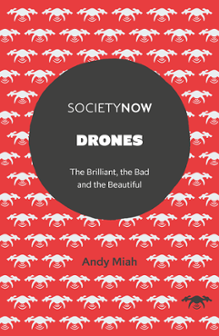Drones: The Brilliant, the Bad and the Beautiful

Synopsis
Table of contents
(9 chapters)Abstract
This chapter examines the catalysts that led drones to become a vast consumer market in a very short space of time. It tells the story of the drone’s resurgence as an object of popular desire and how this reflects a certain kind of technotopian allure, which is found more widely in the technological consumer culture. In so doing, it examines the historical origins of the drone across military aviation and musical culture, along with the major achievements in modern civilian drone exploration. The chapter also draws on literature in design theory, historical analyses of drone patents and speculative fictions within product development to articulate the central drivers behind the proliferation of drones in civil society.
Abstract
This chapter considers the regulatory concerns around drone use, what might be the greatest risks associated with their widespread use in civilian airspace. It also examines the development of regulations as evidence of an emerging moral consciousness. It focusses on regulations developed in the UK and the USA, while drawing attention to the global laws that are beginning to emerge through the United Nations. As well, it examines some of the key controversies associated with civilian drone flight, which range from questions about minimum age, pilot qualifications, matters of personal privacy and the challenge with developing a drone highway in the sky. This chapter provides crucial insights into the state of the art of drone rules providing guidance on what is possible to do legally and what has yet to be fully resolved in terms of public regulation.
Abstract
This chapter examines the proposition that drone technologies are a force for good and discusses a number of applications that have become prominent within this category. It investigates how drones are being used within a growing number of sectors, including leisure, research, health, journalism, and sports, and analysing the development of such pursuits and their implications. It focusses on what resides behind the desire to re-characterise drones as objects of desire – and products more generally – and as vehicles for positive social change. Central to this chapter is the claim that drones are vehicles for asserting agency and competence over technology, but that there is also a trend towards the erosion of skills required to operate such devices, which undermines their overall evaluation has sources of empowerment.
Abstract
This chapter explores how drones are used for morally controversial applications, while also interrogating the distinctiveness of these functions. It focusses on the uses of drones for purposes of human destruction, analysing documentary and film as insights into the impacts of such applications. In so doing, the chapter considers how drones change the nature of military conflict, creating even greater removal of the human subject from the location in which violence occurs. It also inquires into what it means when preparation for war is best achieved through experimental and playful enterprises, such as drone racing and gaming culture. Finally, the chapter documents some of the more harmful uses of drones in civilian crime and disorder contexts.
Abstract
This chapter examines the utilisation of drones for creative expression, focussing on applications which span the use of drones as artistic inquiry and exploration, to their uses as political activism. It begins by discussing the common ground between art and science, proceeding to then analyse critical artistic interventions using drones. Such works function as forms of critical design and investigate the creative potential of drones, as performers and props. In sum, it characterises the emergence of drone art as a distinct new media art form, which locates collaboration at its heart and which exemplifies the value of bridging the art, science and technology divide.
Abstract
This chapter draws together the main themes of the book to outline some crucial trajectories in the development of drones. Notably, it investigates the process towards investing drones with trust in technical and moral terms, while also interrogating the utilisation of technology more broadly as a vehicle of furthering humanity's aims to demonstrate mastery over nature. Furthermore, it analyses the potential of developing fully autonomous drone systems and the consequences of establishing a drone highway. The book concludes by focussing on the presence of the machine as a new, companion species, which confronts humanity with new questions about its place in the world and its capacity to develop rich, meaningful relationships with artificial intelligence, of which drones are among the first examples.

- DOI
- 10.1108/9781838679859
- Publication date
- 2020-02-28
- Book series
- Society Now
-
- Series copyright holder
- Emerald Publishing Limited
- ISBN
- 978-1-83867-988-0
- eISBN
- 978-1-83867-985-9